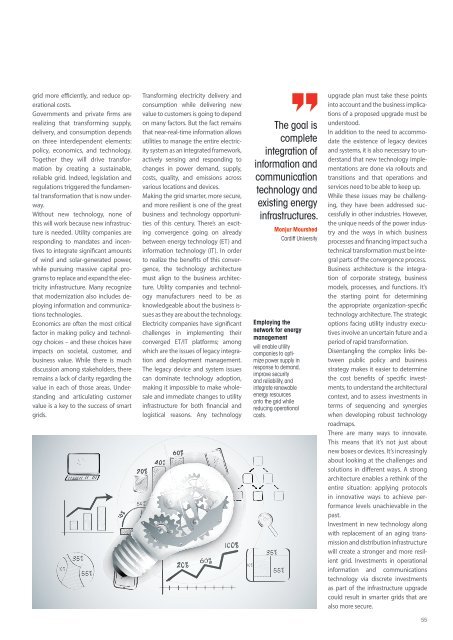Smart Industry 1/2019
Smart Industry 1/2019 - The IoT Business Magazine - powered by Avnet Silica
Smart Industry 1/2019 - The IoT Business Magazine - powered by Avnet Silica
Create successful ePaper yourself
Turn your PDF publications into a flip-book with our unique Google optimized e-Paper software.
grid more efficiently, and reduce operational<br />
costs.<br />
Governments and private firms are<br />
realizing that transforming supply,<br />
delivery, and consumption depends<br />
on three interdependent elements:<br />
policy, economics, and technology.<br />
Together they will drive transformation<br />
by creating a sustainable,<br />
reliable grid. Indeed, legislation and<br />
regulations triggered the fundamental<br />
transformation that is now underway.<br />
Without new technology, none of<br />
this will work because new infrastructure<br />
is needed. Utility companies are<br />
responding to mandates and incentives<br />
to integrate significant amounts<br />
of wind and solar-generated power,<br />
while pursuing massive capital programs<br />
to replace and expand the electricity<br />
infrastructure. Many recognize<br />
that modernization also includes deploying<br />
information and communications<br />
technologies.<br />
Economics are often the most critical<br />
factor in making policy and technology<br />
choices – and these choices have<br />
impacts on societal, customer, and<br />
business value. While there is much<br />
discussion among stakeholders, there<br />
remains a lack of clarity regarding the<br />
value in each of those areas. Understanding<br />
and articulating customer<br />
value is a key to the success of smart<br />
grids.<br />
Transforming electricity delivery and<br />
consumption while delivering new<br />
value to customers is going to depend<br />
on many factors. But the fact remains<br />
that near-real-time information allows<br />
utilities to manage the entire electricity<br />
system as an integrated framework,<br />
actively sensing and responding to<br />
changes in power demand, supply,<br />
costs, quality, and emissions across<br />
various locations and devices.<br />
Making the grid smarter, more secure,<br />
and more resilient is one of the great<br />
business and technology opportunities<br />
of this century. There’s an exciting<br />
convergence going on already<br />
between energy technology (ET) and<br />
information technology (IT). In order<br />
to realize the benefits of this convergence,<br />
the technology architecture<br />
must align to the business architecture.<br />
Utility companies and technology<br />
manufacturers need to be as<br />
knowledgeable about the business issues<br />
as they are about the technology.<br />
Electricity companies have significant<br />
challenges in implementing their<br />
converged ET/IT platforms; among<br />
which are the issues of legacy integration<br />
and deployment management.<br />
The legacy device and system issues<br />
can dominate technology adoption,<br />
making it impossible to make wholesale<br />
and immediate changes to utility<br />
infrastructure for both financial and<br />
logistical reasons. Any technology<br />
The goal is<br />
complete<br />
integration of<br />
information and<br />
communication<br />
technology and<br />
existing energy<br />
infrastructures.<br />
Monjur Mourshed<br />
Cardiff University<br />
Employing the<br />
network for energy<br />
management<br />
will enable utility<br />
companies to optimize<br />
power supply in<br />
response to demand,<br />
improve security<br />
and reliability, and<br />
integrate renewable<br />
energy resources<br />
onto the grid while<br />
reducing operational<br />
costs.<br />
upgrade plan must take these points<br />
into account and the business implications<br />
of a proposed upgrade must be<br />
understood.<br />
In addition to the need to accommodate<br />
the existence of legacy devices<br />
and systems, it is also necessary to understand<br />
that new technology implementations<br />
are done via rollouts and<br />
transitions and that operations and<br />
services need to be able to keep up.<br />
While these issues may be challenging,<br />
they have been addressed successfully<br />
in other industries. However,<br />
the unique needs of the power industry<br />
and the ways in which business<br />
processes and financing impact such a<br />
technical transformation must be integral<br />
parts of the convergence process.<br />
Business architecture is the integration<br />
of corporate strategy, business<br />
models, processes, and functions. It’s<br />
the starting point for determining<br />
the appropriate organization-specific<br />
technology architecture. The strategic<br />
options facing utility industry executives<br />
involve an uncertain future and a<br />
period of rapid transformation.<br />
Disentangling the complex links between<br />
public policy and business<br />
strategy makes it easier to determine<br />
the cost benefits of specific investments,<br />
to understand the architectural<br />
context, and to assess investments in<br />
terms of sequencing and synergies<br />
when developing robust technology<br />
roadmaps.<br />
There are many ways to innovate.<br />
This means that it’s not just about<br />
new boxes or devices. It’s increasingly<br />
about looking at the challenges and<br />
solutions in different ways. A strong<br />
architecture enables a rethink of the<br />
entire situation: applying protocols<br />
in innovative ways to achieve performance<br />
levels unachievable in the<br />
past.<br />
Investment in new technology along<br />
with replacement of an aging transmission<br />
and distribution infrastructure<br />
will create a stronger and more resilient<br />
grid. Investments in operational<br />
information and communications<br />
technology via discrete investments<br />
as part of the infrastructure upgrade<br />
could result in smarter grids that are<br />
also more secure.<br />
55
















